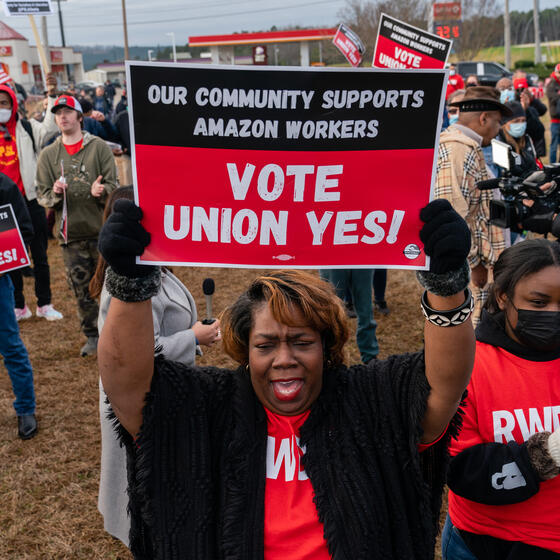Competition from China Contributed to Decline in Union Organizing
New research co-authored by Yale SOM Dean Kerwin K. Charles shows that the rise in imports from China at the beginning of this century accelerated a long decline in union elections, by diminishing the benefits of unionization and increasing the risk.

A rally supporting unionization for Amazon workers in Bessemer, Alabama, in February 2022.
Earlier this year, the New York Times reported that the popularity of the labor movement is the highest it has been in decades—but union membership has fallen by half since the 1980s. If Americans recognize the benefits of unionization, why don’t more of them join unions?
In a new working paper, Dean Kerwin K. Charles and his co-authors propose a partial explanation. They note that the rate of union organizing in the United States has fallen sharply over the last four decades, with the decline accelerating around the year 2000. Meanwhile, Chinese imports rose in the 1990s and then accelerated in 2000 after China joined the World Trade Organization—what economists call the “China shock.” Did economic pressure from China contribute to the decline in union organization?
Charles and his co-authors, Matthew S. Johnson of Duke University and Nagisa Tadjfar of MIT, conclude that it did. Between 1990 and 2007, they estimate, the China shock decreased union elections by 4.5% among workers in the manufacturing industries directly exposed to competition from Chinese imports. But the effect went beyond those industries. Among workers indirectly affected by imports in their local labor markets, there was an even larger impact, with 8.8% fewer elections.
How did Chinese imports affect the rate of union organizing not just in the manufacturing industries competing with Chinese companies but also in non-manufacturing industries? Charles and his team identify two separate mechanisms for this impact.
At companies directly exposed to Chinese imports, they hypothesize, competition lowers profitability; for workers, that means that the potential gains from unionizing are smaller. In other words, since they are bargaining over a smaller pie, unionized workers can expect a smaller increase over non-union wages, decreasing their motivation to unionize.
Meanwhile, they suggest, there is an indirect effect on workers throughout a local labor market that includes companies facing competition from China. If the competition facing manufacturers lowers overall employment rates and wages in that labor market, workers in all local industries would be more reluctant to unionize. This reluctance arises because union organizing raises the risk of job loss—both because companies might retaliate against workers leading organizing efforts and because successful organizing might lead companies to cut jobs—and worse local labor market conditions make job loss more costly.
The team found support for the first hypothesis in data on collective bargaining agreements by private-sector unions since 1990. The data showed that exposure to Chinese competition in an industry did indeed lower wage gains in the agreements; specifically, for every 1 percentage point increase in Chinese import penetration of a company’s industry, the union-negotiated wage increase dropped by .12%.
Looking at the local labor markets where some companies facing competition from China, the researchers first verified that a separate mechanism is at work; such exposure to China was not associated with smaller union-negotiated wage increases for most workers in the area. But across these areas, they found, there were substantial market wage reductions, especially in non-manufacturing industries. Together, this evidence supports the idea that the risk of job loss is behind declines in union elections in these areas.
“It is well-documented that wages have stagnated for the majority of U.S. workers in recent decades,” the authors write. “A key question in labor economics is the degree to which this trend is driven by fundamentals (such as the rise in international trade or skill-biased technical change) versus institutions (such as the decline in labor unions). One implication of our paper is that these explanations are not necessarily mutually exclusive. We find that the rise in Chinese import competition (one of the ‘fundamentals’) led to a decline in workers’ efforts to organize for unions (one of the ‘institutions’), which may have interacted with and compounded each other to affect changes in the wage structure.”